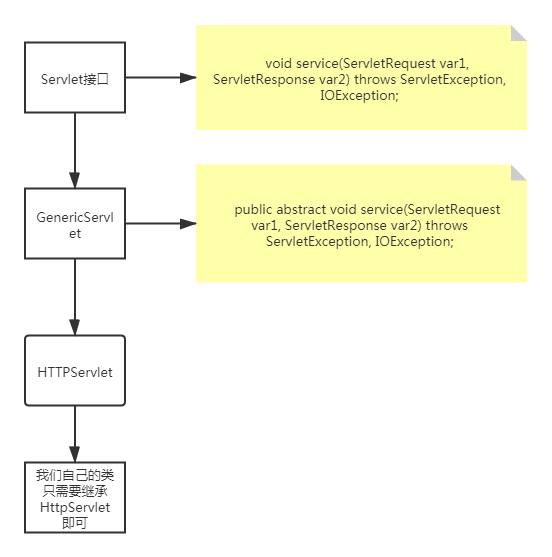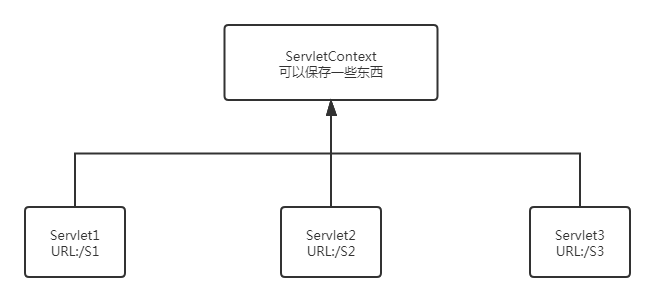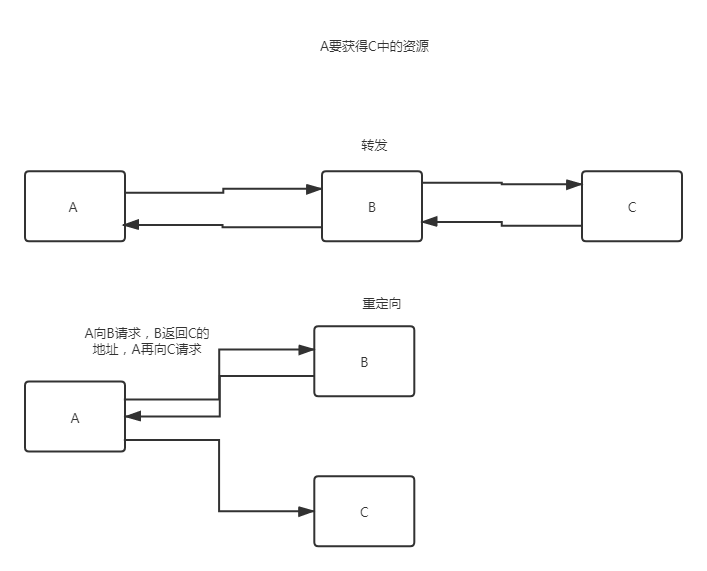Servlet
Servlet
1. Servlet简介
- sun公司开发动态web的一门技术
- sun公司在这些API中提供一个接口叫做:Servlet。如果你想开发一个Servlet程序,只需要完成两个小步骤
- 编写一个类,实现servlet接口
- 把开发好的java类部署到web服务器中
把实现了servlet接口的java程序叫做servelet
2. HelloServlet
Servlet接口在sun公司有两个默认的实现类:HttpServlet,GenericServlet
-
构建一个普通的Maven项目,删掉里面的src目录,以后我们的学习就在这里面建立module;这个空的工程就是Maven的主工程;以webapp为模板建立一个子工程
-
关于Maven父子工程的理解:
父项目中会有
<modules> <module>servlet-01</module> </modules>子项目中会有
<parent> <artifactId>HelloServlet</artifactId> <groupId>org.example</groupId> <version>1.0-SNAPSHOT</version> </parent>父项目中的jar包子项目中可以直接使用(类似java中的继承)
-
Maven环境优化
-
修改web.xml为最新的
<?xml version="1.0" encoding="UTF-8"?> <web-app xmlns="http://xmlns.jcp.org/xml/ns/javaee" xmlns:xsi="http://www.w3.org/2001/XMLSchema-instance" xsi:schemaLocation="http://xmlns.jcp.org/xml/ns/javaee http://xmlns.jcp.org/xml/ns/javaee/web-app_4_0.xsd" version="4.0" metadata-complete="true"> </web-app> -
将maven的结构搭建完整
-
-
编写一个servlet程序
-
编写一个普通类
-
实现servlet接口,这里我们直接继承HttpServlet

public class HelloServlet extends HttpServlet { //由于get或者post只是请求实现的不同方式,可以相互调用,业务逻辑都一样 @Override protected void doGet(HttpServletRequest req, HttpServletResponse resp) throws ServletException, IOException { //ServletOutputStream outputStream = resp.getOutputStream(); PrintWriter writer = resp.getWriter(); //响应流 writer.print("Hello, Serlvet"); } @Override protected void doPost(HttpServletRequest req, HttpServletResponse resp) throws ServletException, IOException { doGet(req, resp); } }
-
-
编写servlet的映射
为什么需要映射:我们写的是Java程序,但是要通过浏览器访问,而浏览器需要连接web服务器,所以我们需要在web服务中注册我们写的servlet,还需要给他一个浏览器能够访问的路径
<!--注册Servlet--> <servlet> <servlet-name>hello</servlet-name> <servlet-class>com.wang.servlet.HelloServlet</servlet-class> </servlet> <!--Servlet的请求路径--> <servlet-mapping> <servlet-name>hello</servlet-name> <url-pattern>/hello</url-pattern> </servlet-mapping> -
配置Tomcat
注意配置项目发布的路径就可以了
-
启动测试
注意!写url时不要忘了加/
<!--Servlet的请求路径-->
<servlet-mapping>
<servlet-name>hello</servlet-name>
<url-pattern>/hello</url-pattern>
</servlet-mapping>
3. Servlet原理
servlet是由web服务器调用,web服务器在收到浏览器请求之后会:

4. Mapping问题
-
一个Servlet可以指定一个映射路径
<servlet-mapping> <servlet-name>hello</servlet-name> <url-pattern>/hello</url-pattern> </servlet-mapping> -
一个Servlet可以指定多个映射路径
<servlet-mapping> <servlet-name>hello</servlet-name> <url-pattern>/hello</url-pattern> </servlet-mapping> <servlet-mapping> <servlet-name>hello</servlet-name> <url-pattern>/hello1</url-pattern> </servlet-mapping> -
一个Servlet可以指定通用映射路径(通配符)
<servlet-mapping> <servlet-name>hello</servlet-name> <url-pattern>/hello/*</url-pattern> </servlet-mapping>注意,下面的是默认请求路径,尽量避免这样写!
<servlet-mapping> <servlet-name>hello</servlet-name> <url-pattern>/*</url-pattern> </servlet-mapping> -
可以自定义后缀实现请求映射
注意,.*前面不能加项目映射的路径
<servlet-mapping> <servlet-name>hello</servlet-name> <url-pattern>*.wang</url-pattern> </servlet-mapping>以下均为非法写法
<servlet-mapping> <servlet-name>hello</servlet-name> <url-pattern>/*.wang</url-pattern> </servlet-mapping><servlet-mapping> <servlet-name>hello</servlet-name> <url-pattern>/hello/*.wang</url-pattern> </servlet-mapping> -
优先级问题
指定了固有的映射路径优先级最高,如果找不到就会走默认的路径
例如处理404请求
<!--404--> <servlet> <servlet-name>error</servlet-name> <servlet-class>com.wang.servlet.ErrorServlet</servlet-class> </servlet> <servlet-mapping> <servlet-name>error</servlet-name> <url-pattern>/*</url-pattern> </servlet-mapping>
5. ServletContext
web容器在启动的时候,他会为每个web程序都创建一个对应的ServletContext对象,他代表了当前的web应用;
1. 共享数据
我在这个Servlet中保存的数据,可以在另一个Servlet中拿到

放入——>取出——>配置mapping
public class HelloServlet extends HttpServlet {
@Override
protected void doGet(HttpServletRequest req, HttpServletResponse resp) throws ServletException, IOException {
//this.getInitParameter(); 初始化参数
//this.getServletConfig(); Servlet配置
//this.getServletContext(); Servlet上下文
ServletContext context = this.getServletContext();
String username = "王诗凯"; //数据
context.setAttribute("username", username); //将一个数据保存在ServletContext中,名字为username,值username
System.out.println("Hello");
}
}
public class GetServlet extends HttpServlet {
@Override
protected void doGet(HttpServletRequest req, HttpServletResponse resp) throws ServletException, IOException {
ServletContext context = this.getServletContext(); //拿到的是同一个ServletContext,因为全局唯一
String username = (String)context.getAttribute("username");
//resp.setHeader();
resp.setContentType("text/html");
resp.setCharacterEncoding("utf-8");
resp.getWriter().print("名字 " + username);
}
@Override
protected void doPost(HttpServletRequest req, HttpServletResponse resp) throws ServletException, IOException {
super.doGet(req, resp);
}
}
<servlet>
<servlet-name>hello</servlet-name>
<servlet-class>com.wang.servlet.HelloServlet</servlet-class>
</servlet>
<servlet-mapping>
<servlet-name>hello</servlet-name>
<url-pattern>/hello</url-pattern>
</servlet-mapping>
<servlet>
<servlet-name>getc</servlet-name>
<servlet-class>com.wang.servlet.GetServlet</servlet-class>
</servlet>
<servlet-mapping>
<servlet-name>getc</servlet-name>
<url-pattern>/getc</url-pattern>
</servlet-mapping>
测试访问结果
2. 获取初始化参数
<!--配置一些web应用初始化参数-->
<context-param>
<param-name>url</param-name>
<param-value>jdbc:mysql://localhost:3306/mybatis</param-value>
</context-param>
@Override
protected void doGet(HttpServletRequest req, HttpServletResponse resp) throws ServletException, IOException {
ServletContext context = this.getServletContext(); //拿到的是同一个ServletContext,因为全局唯一
String url = context.getInitParameter("url");
resp.getWriter().print(url);
}
3. 请求转发
@Override
protected void doGet(HttpServletRequest req, HttpServletResponse resp) throws ServletException, IOException {
ServletContext context = this.getServletContext(); //拿到的是同一个ServletContext,因为全局唯一
System.out.println("进入了ServletDemo04");
/*
RequestDispatcher requestDispatcher = context.getRequestDispatcher("/gp"); //转发请求路径
requestDispatcher.forward(req, resp); //调用forward实现请求转发
*/
context.getRequestDispatcher("/gp").forward(req, resp);
}

4. 读取资源文件
Properties
- 在Java目录下新建properties
- 在resource目录下新建properties
发现:都被打包到了同一个路径下:classes,我们俗称这个路径为类路径
思路:需要一个文件流
@Override
protected void doGet(HttpServletRequest req, HttpServletResponse resp) throws ServletException, IOException {
InputStream is = this.getServletContext().getResourceAsStream("/WEB-INF/classes/db.properties");
Properties prop = new Properties();
prop.load(is);
String user = prop.getProperty("username");
String pwd = prop.getProperty("password");
resp.getWriter().print(user + ":" + pwd);
}
访问测试即可
6. HttpServletResponse
web服务器接收到客户端的http请求,针对这个请求,分别创建一个代表请求的HttpServletRequest对象,代表响应的一个HttpServletResponse;
- 如果要获取客户端请求过来的参数:找HttpServletRequest
- 如果要给客户端响应一些信息:找HttpServletResponse
1. 简单分类
负责向浏览器发送数据的方法
servletOutputStream getOutputStream() throws IOException;
PrintWriter getWriter() throws IOException;
负责向浏览器发送响应头的方法
void setDateHeader(String var1, long var2);
void addDateHeader(String var1, long var2);
void setHeader(String var1, String var2);
void addHeader(String var1, String var2);
void setIntHeader(String var1, int var2);
void addIntHeader(String var1, int var2);
void setCharacterEncoding(String var1);
void setContentLength(int var1);
void setContentLengthLong(long var1);
void setContentType(String var1);
响应的状态码
int SC_CONTINUE = 100;
int SC_SWITCHING_PROTOCOLS = 101;
int SC_OK = 200;
int SC_CREATED = 201;
int SC_ACCEPTED = 202;
int SC_NON_AUTHORITATIVE_INFORMATION = 203;
int SC_NO_CONTENT = 204;
int SC_RESET_CONTENT = 205;
int SC_PARTIAL_CONTENT = 206;
int SC_MULTIPLE_CHOICES = 300;
int SC_MOVED_PERMANENTLY = 301;
int SC_MOVED_TEMPORARILY = 302;
int SC_FOUND = 302;
int SC_SEE_OTHER = 303;
int SC_NOT_MODIFIED = 304;
int SC_USE_PROXY = 305;
int SC_TEMPORARY_REDIRECT = 307;
int SC_BAD_REQUEST = 400;
int SC_UNAUTHORIZED = 401;
int SC_PAYMENT_REQUIRED = 402;
int SC_FORBIDDEN = 403;
int SC_NOT_FOUND = 404;
int SC_METHOD_NOT_ALLOWED = 405;
int SC_NOT_ACCEPTABLE = 406;
int SC_PROXY_AUTHENTICATION_REQUIRED = 407;
int SC_REQUEST_TIMEOUT = 408;
int SC_CONFLICT = 409;
int SC_GONE = 410;
int SC_LENGTH_REQUIRED = 411;
int SC_PRECONDITION_FAILED = 412;
int SC_REQUEST_ENTITY_TOO_LARGE = 413;
int SC_REQUEST_URI_TOO_LONG = 414;
int SC_UNSUPPORTED_MEDIA_TYPE = 415;
int SC_REQUESTED_RANGE_NOT_SATISFIABLE = 416;
int SC_EXPECTATION_FAILED = 417;
int SC_INTERNAL_SERVER_ERROR = 500;
int SC_NOT_IMPLEMENTED = 501;
int SC_BAD_GATEWAY = 502;
int SC_SERVICE_UNAVAILABLE = 503;
int SC_GATEWAY_TIMEOUT = 504;
int SC_HTTP_VERSION_NOT_SUPPORTED = 505;
2. 常见应用
- 向浏览器输出信息
- 下载文件
- 要获取下载文件的路径
- 下载的文件名是啥?
- 设置想办法让浏览器能够支持下载我们需要的东西
- 获取下载文件的输出流
- 创建缓冲流
- 获取OutputStream对象
- 将FileOutputStream流写入到Buffer缓冲区
- 使用OutputStream将缓冲区的数据输出到客户端
@Override
protected void doGet(HttpServletRequest req, HttpServletResponse resp) throws ServletException, IOException {
//1. 要获取下载文件的路径
//D:\JavaWeb\HelloServlet\response\target\classes\TIM截图20200728172813.png
//String realPath = this.getServletContext().getRealPath("/TIM截图20200728172813.png");
String realPath = "D:\\JavaWeb\\HelloServlet\\response\\target\\classes\\TIM截图20200728172813.png";
System.out.println("下载文件的路径:" + realPath);
//2. 下载的文件名是啥?
String fileName = realPath.substring(realPath.lastIndexOf("\\") + 1);
//3. 设置想办法让浏览器能够支持(Content-Disposition)下载我们需要的东西,中文文件名用URLEncoder.encode编码,否则可能乱码
resp.setHeader("Content-Disposition","attachment;filename=" + URLEncoder.encode(fileName,"utf-8"));
//4. 获取下载文件的输出流
FileInputStream in = new FileInputStream(realPath);
//5. 创建缓冲流
int len = 0;
byte[] buffer = new byte[1024];
//6. 获取OutputStream对象
ServletOutputStream out = resp.getOutputStream();
//7. 将FileOutputStream流写入到Buffer缓冲区
//8. 使用OutputStream将缓冲区的数据输出到客户端
while ((len = in.read(buffer)) > 0){
out.write(buffer, 0, len);
}
in.close();
out.close();
}
-
验证码功能
验证码怎么来的
- 前端实现
- 后端实现,需要用到Java的图片类,生成一个图片
@Override
protected void doGet(HttpServletRequest req, HttpServletResponse resp) throws ServletException, IOException {
//如何让浏览器3s刷新一次
resp.setHeader("refresh","3");
//在内存中创建一个图片
BufferedImage image = new BufferedImage(100, 20, BufferedImage.TYPE_INT_RGB);
//得到图片
Graphics2D g = (Graphics2D) image.getGraphics(); //笔
//设置图片的背景颜色
g.setColor(Color.white);
g.fillRect(0,0,100,20);
//给图片写数据
g.setColor(Color.blue);
g.setFont(new Font(null, Font.BOLD, 20));
g.drawString(makeNum(), 0, 20);
//告诉浏览器,这个请求用图片的方式打开
resp.setContentType("image/jpeg");
//网站存在缓存,不让浏览器请求
resp.setDateHeader("expires", -1);
resp.setHeader("Cache-Control", "no-cache");
resp.setHeader("Pragma", "no-cache");
//把图片写给浏览器
ImageIO.write(image, "jpg", resp.getOutputStream());
}
//生成随机数
private String makeNum(){
Random random = new Random();
String num = random.nextInt(99999999) + "";
StringBuffer sb = new StringBuffer();
//防止数字不满8位,空位用0填充
for (int i = 0; i < 7 - num.length(); i++) { //快捷键 fori
sb.append("0");
}
String s = sb.toString() + num;
return num;
}
- 4.实现重定向
一个web资源受到客户端请求后,他会通知客户端去访问另外一个web资源,这个过程叫重定向
常见场景:
- 用户登录
void sendRedirect(String var1) throws IOException;
测试
@Override
protected void doGet(HttpServletRequest req, HttpServletResponse resp) throws ServletException, IOException {
/*重定向的原理
resp.setHeader("Location", "/response/img");
resp.setStatus(302)
*/
resp.sendRedirect("/response/img"); //重定向
}
面试题:请你聊聊重定向和转发的区别
相同点
- 页面都会跳转
不同点
- 请求转发的时候。url不会产生变化 307
- 重定向的时候,url地址栏会发生变化 302
- 原理图如下

request重定向
@Override
protected void doGet(HttpServletRequest req, HttpServletResponse resp) throws ServletException, IOException {
//处理请求
String username = req.getParameter("username");
String password = req.getParameter("password");
System.out.println(username + ":" + password);
//重定向时候一定要注意,路径问题,否则404
resp.sendRedirect("/response/success.jsp");
}
index.jsp
<html>
<body>
<h2>Hello World!</h2>
<%--这里提交的路径,需要寻找到项目的路径--%>
<%--${pageContext.request.contextPath}代表当前的的项目--%>
<form action="${pageContext.request.contextPath}/login" method="get">
用户名:<input type = "text" name="username">
密码:<input type="password" name="password">
<input type="submit">
</form>
</body>
</html>
success.jsp
<%@ page contentType="text/html;charset=UTF-8" language="java" %>
<html>
<head>
<title>Success</title>
</head>
<body>
<h2>Success</h2>
</body>
</html>
7. HttpServletRequset
HttpServletRequest代表客户端的请求,用户通过Http协议访问服务器,Http请求中的所有信息会被封装到HttpServletRequest,通过这个HttpServletRequest的方法,获得客户端的所有信息
获取参数,并请求转发
@Override
protected void doGet(HttpServletRequest req, HttpServletResponse resp) throws ServletException, IOException {
//后台接受中文乱码问题
req.setCharacterEncoding("utf-8");
resp.setCharacterEncoding("utf-8");
String username = req.getParameter("username");
String password = req.getParameter("password");
String[] hobbies = req.getParameterValues("hobbies");
System.out.println("===================================");
System.out.println(username);
System.out.println(password);
System.out.println(Arrays.toString(hobbies));
System.out.println("===================================");
//通过请求转发
System.out.println(req.getContextPath());
//说明:转发是内部资源,写相对路径;重定向是外部资源,写绝对路径
req.getRequestDispatcher("success.jsp").forward(req, resp);
}
index.jsp
<%@ page contentType="text/html;charset=UTF-8" language="java" %>
<html>
<head>
<title>登录</title>
</head>
<body>
<h1>登录</h1>
<div style="text-align: center">
<%--这里表单表示的意思:以post方式提交表单,提交到我们的login请求--%>
<form action="${pageContext.request.contextPath}/login" method="post">
用户名:<input type="text" name="username"> <br>
密码:<input type="password" name = "password"> <br>
爱好:
<input type="checkbox" name = "hobbies" value="女孩">女孩
<input type="checkbox" name = "hobbies" value="代码">代码
<input type="checkbox" name = "hobbies" value="唱歌">唱歌
<input type="checkbox" name = "hobbies" value="电影">电影
<br>
<input type="submit">
</form>
</div>
</body>
</html>
success.jsp
<%--
Created by IntelliJ IDEA.
User: a000248
Date: 2020/7/30
Time: 11:14
To change this template use File | Settings | File Templates.
--%>
<%@ page contentType="text/html;charset=UTF-8" language="java" %>
<html>
<head>
<title>Title</title>
</head>
<body>
<h1>登录成功!</h1>
</body>
</html>


 浙公网安备 33010602011771号
浙公网安备 33010602011771号